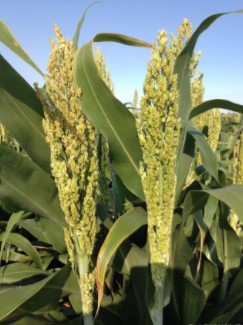By Michelle Leinfelder-Miles
We are continuing a trial that we began last year to evaluate optimum seeding rates for grain sorghum. UC research on sorghum has increased over the last few years, primarily in the southern San Joaquin Valley, to evaluate grain and silage sorghum for its adaptability to drought and low-input conditions. This seeding rate trial complements those efforts to provide management information for California growers. The 2017 trial was planted on May 25th, approximately 5 days later than last year's trial, in the Sacramento County Delta. The variety is Eureka Seeds 3325W. The trial consists of five replicated blocks of five treatments: 5, 6, 9, 12, and 15 pounds per acre. These treatments correspond to approximate plant populations of 68,000, 81,600, 122,400, 163,200, and 204,000 plants per acre, respectively. (This takes into account the 85 percent germination for the variety.) To date, we have taken stand and weed counts and have been monitoring bloom (Fig. 1). On average across treatments, bloom occurred 70 days after planting, compared to 71 days last year. At the end of the season, we will measure grain moisture and yield in an effort to better understand optimum seeding rates. Results from last year's trial are available from my website.

Figure 1. Sorghum panicle at bloom (left). Notice the panicle is shedding orange pollen. Bloom occurs when at least half of the panicle is shedding pollen.